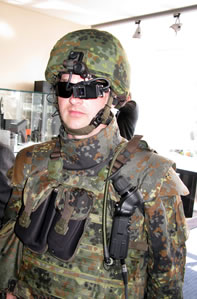German Infantry of the Future – Expanded System
 On September 1st, 2006 the German Bundeswehr has awarded Rheinmetall Defence a multi-million Euro contract to develop an advanced version of the future infantry combat suite for German infantrymen. Following the delivery of idZ ES demonstrators in 2008 for testing, the German Army is expected to open the program for competition, where both Rheinmetall Defense and EADS, (which supplied the baseline idZ and idZ V1 systems) will compete on the production and support of the systems. Large scale production is expected to begin around 2009, to equip Germany’s infantry, armored infantry, air force security troops and naval special operations units. This version is scheduled to enter service with the German infantry by 2011, as the Bundeswehr is slated to order the first 939 systems.
On September 1st, 2006 the German Bundeswehr has awarded Rheinmetall Defence a multi-million Euro contract to develop an advanced version of the future infantry combat suite for German infantrymen. Following the delivery of idZ ES demonstrators in 2008 for testing, the German Army is expected to open the program for competition, where both Rheinmetall Defense and EADS, (which supplied the baseline idZ and idZ V1 systems) will compete on the production and support of the systems. Large scale production is expected to begin around 2009, to equip Germany’s infantry, armored infantry, air force security troops and naval special operations units. This version is scheduled to enter service with the German infantry by 2011, as the Bundeswehr is slated to order the first 939 systems.
Dubbed “Future Soldier – Expanded System” (IdZ-ES), the new system will introduce a new wearable computer and advanced networking into existing idZ systems. The idZ ES computer and communications systems will be fully integrated with the system’s sensors, helmet system display and voice radio, navigation aids, body armor and load carrying system.
According to Rheinmetall, IdZ-ES will utilize fully digital voice, data and video communications and will be interoperable with the German Army’s FuInfoSys command and information system and fully support NATO standards for full interoperability as part of coalition forces. A GPS-integrated digital display will provide support the presentation of situational picture, which can be monitored at all echelons of command. The system will benefit from Rheinmetall’s “Interconnected Command Control Communications Computer Unit” (IC4U) which enables real-time exchange of data between individual infantrymen, the section vehicle and relevant networks. In addition, the contract encompasses development of a wide array of sensor packages for fire control and mine detection. Rheinmetall is also working with other project partners to develop a new visor-equipped helmet, together with a system for monitoring the soldier’s health status.
The IDz-ES focuses on ergonomics and networking integrating miniaturized, lighter and power efficient systems, while some of the weight saving are exchanged for improved protection. The IDz-ES concept draws on the combined capabilities of the fully networked 10 member squad and their vehicle acting as a ‘base station’. Therefore, the core IDZ-ES kit incorporates the wearable computing and helmet systems, the weapon, the clothing including camouflage and CBR protection; the body armor protective vest offers basic protection level and can be extended up to level 4 wit modular enhancements. The integral load bearing web gear is fitted with modular load carriage for ammunition, supplies, batteries and ‘electronic back’ comprising the computer elements.
The squad leader specific equipment includes a portable computer and VHF squad radio which supplements the UHF personnel radios carried by other squad members. Sights and observation systems and complimentary ‘base station’ elements such as chargers and and vehicular wireless link. The system’s core computer runs a Linux operating system, handling all soldier related functions including mapping, situational display, navigation, reporting, imaging and information exchange across different systems.
The system’s elements (weapon, helmet and core) are linked via wireless personal area network (WPAN) system. The squad radios can form ad-hoc networking schemes, carrying voice, data and video transmission between specific IP addresses; in fact, each member can link to higher echelon command systems via the vehicle’s radio, providing gateway to networks to the world, including the new Army battle management system known as FuInfoSys H and FuWESIFIS. IDZ-ES is designed to exchange information with other systems by conforming to NATO data exchange protocols defined by MIP/DEM procedures.
As part of the program, IdZ-ES technology will also be integrated into armored vehicle systems such as the Puma infantry fighting vehicle and Boxer armored personnel carrier as well as the future, lightweight air-portable combat vehicles.
















